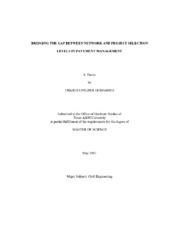| dc.contributor.advisor | Gharaibeh, Nasir G. | |
| dc.creator | Gurganus, Charles Felder | |
| dc.date.accessioned | 2011-08-08T22:48:36Z | |
| dc.date.accessioned | 2011-08-09T01:31:22Z | |
| dc.date.available | 2011-08-08T22:48:36Z | |
| dc.date.available | 2011-08-09T01:31:22Z | |
| dc.date.created | 2011-05 | |
| dc.date.issued | 2011-08-08 | |
| dc.date.submitted | May 2011 | |
| dc.identifier.uri | https://hdl.handle.net/1969.1/ETD-TAMU-2011-05-9265 | |
| dc.description.abstract | Pavement management is one of the primary responsibilities for departments of transportation and other municipalities across the country. Efficient and proper use of taxpayer dollars to preserve and improve the existing transportation system has never been more important due to the current fiscal environment. Agencies use pavement management systems to store data describing the state of the network. This information is often used to help make decisions regarding the location of pavement preservation actions. There is often a discrepancy between the need estimates of network-level pavement management systems and where and how pavement preservation and improvement dollars are actually spent (i.e., actual pavement preservation and improvement projects). This research focuses on evaluating the Texas Department of Transportation’s (TxDOT) Pavement Management Information System (PMIS) to assess the agreement between its need estimates and actual construction projects at the district level. The research revealed there is little agreement between the output of PMIS’s Needs Estimate tool and actual construction projects. Possible reasons for this disagreement include the inability of PMIS’s Needs Estimates to consider the decision makers preferences and priorities, and also its inability to consider multiple years of condition data simultaneously. Through the use of the Analytic Hierarchy Process (AHP), the research was able to capture the effect of several variables on the decision making process. Using this method, pavement project suggestions were created that more closely matched actual projects than what the current Needs Estimate tool suggests.
The projects selected using the new method were then tested against actual construction within three counties of the Bryan district. The new method closely matches actual preservation decisions made by the district within these three counties. | en |
| dc.format.mimetype | application/pdf | |
| dc.language.iso | en_US | |
| dc.subject | PMIS | en |
| dc.subject | Pavement Management | en |
| dc.subject | AHP | en |
| dc.subject | Analytic Hierarchy Process | en |
| dc.subject | Pavement Preservation | en |
| dc.subject | Decision Making | en |
| dc.title | Bridging the Gap between Network and Project Selection Levels in Pavement Management | en |
| dc.type | Thesis | en |
| thesis.degree.department | Civil Engineering | en |
| thesis.degree.discipline | Civil Engineering | en |
| thesis.degree.grantor | Texas A&M University | en |
| thesis.degree.name | Master of Science | en |
| thesis.degree.level | Masters | en |
| dc.contributor.committeeMember | Anderson, Stuart D. | |
| dc.contributor.committeeMember | Lomax, Timothy J. | |
| dc.type.genre | thesis | en |
| dc.type.material | text | en |


